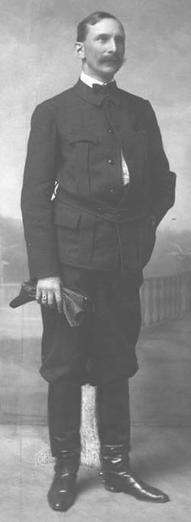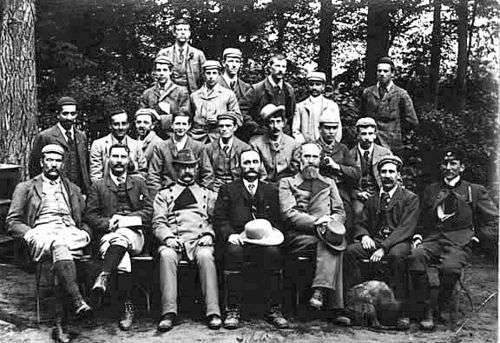Carl A. Schenck
Carl Alwyn Schenck (March 25, 1868 – May 17, 1955) was a pioneering forestry educator in North America, known for his contributions as the forester for George W. Vanderbilt's Biltmore Estate, and the founder of the Biltmore Forest School, the first practical forestry school in the United States, in 1898, near Brevard, NC.
Carl A. Schenck | |
|---|---|
 Carl Schenck in German riding costume, 1905 | |
| Born | March 25, 1868 |
| Died | May 17, 1955 (aged 87) |
| Nationality | German |
| Citizenship | Germany |
| Alma mater | University of Giessen |
| Known for | Forester, George W. Vanderbilt's Biltmore Estate 1895-1909; Founder, Biltmore Forest School |
| Scientific career | |
| Fields | Forestry |
| Institutions | Biltmore Forest School |
| Author abbrev. (botany) | C.A.Schenck |
Education and early life
Schenck was born in 1868 in the town of Darmstadt, Germany. From his youth he looked to forestry as a career, graduating from the Institute of Technology in Darmstadt at age 18. Two years later he enrolled for graduate study at the forest school of the University of Giessen. At Giessen he studied for a time under visiting professor Sir Dietrich Brandis, an influential German-born forester who had played a large part in introducing forestry into the British Empire, working in the forests of India and various other places. Brandis also had a great interest in forestry work in the United States. Schenck completed his Ph.D. degree at the beginning of 1895, and was at that time recommended by Brandis for a job in the United States working for George W. Vanderbilt. Schenck decided to accept the offer from Vanderbilt and sailed to America, arriving in New York City on April 5, 1895.[1]

Biltmore
George W. Vanderbilt’s Biltmore Estate near Asheville, North Carolina, included some 120,000 acres (490 km2) of mountain land. With these extensive forest land holdings, Vanderbilt had decided during the early 1890s that he wanted his forests managed using the best scientific principles of forestry. At this time there were only two trained foresters in the U.S.: American Gifford Pinchot and German Bernard Fernow. When Schenck arrived in America at Vanderbilt's request, he became the third.
Schenck took over the position of Biltmore Estate forester, and immediately got to work managing the vast land holdings. Schenck worked on various forest plantations, setting up tree nurseries, seed extraction and regeneration efforts, logging areas and sawmills, as well as splash dams and fish hatcheries in the rivers. Schenck used new scientific management and practical forestry techniques which had never before been applied to American forests.
In 1898, with the permission of George Vanderbilt, Schenck founded the Biltmore Forest School, the first forestry school in the United States. The school opened on the Biltmore Estate grounds on September 1, 1898, one month before Fernow's opening of the New York State College of Forestry at Cornell University.[2] The Biltmore Forest School offered a one-year course of study, and the curriculum focused on providing traditional classroom lectures in silvicultural theory supplemented with extensive hands-on, practical forest management field training. The school operated successfully on the Biltmore grounds from 1898 to 1909, turning out many of the leading American foresters over this time period.
In November 1908, Schenck hosted the Biltmore Forest Fair, designed to demonstrate to visitors the accomplishments and possibilities of scientific management and practical forestry techniques as well as to celebrate the 10th anniversary of his Forest School. The 3-day festival on the Biltmore grounds featured between 50 and 100 guests, and successfully demonstrated the real-life results of Schenck's forestry and conservation practices.
Vanderbilt's forest ventures had always been unprofitable. Following several years that Schenck was unpaid but paid many employees out of his own pocket, in 1909 Schenck and Vanderbilt quarreled and Schenck was dismissed as forester of the Vanderbilt estate.[3] Although the Biltmore Forest School was financially self-sustaining, he could no longer operate it on Vanderbilt's property. Schenck continued the school through 1913, though, by traveling with his students and operating from various locations including railway cars and locations in Germany.[3]
Schenck's sustainable management theories and inclusion of hands-on training would influence forestry education in the U.S. for generations.
Later life
Schenck spent much of the rest of his life traveling throughout the world giving lectures on scientific forestry. With his friend Ferdinand Luthmer he built a summer cottage in Lindenfels, which was partially constructed out of American wood species.
From 1916 to 1918 he was guest lecturer for forestry in Gießen. From 1923 to 1937 he was visiting professor at the department of forestry of the University of Montana in Missoula.
During the 1930s Schenck worked to promote Douglas Fir plantings in German forests. He expressed enthusiasm for National Socialist forestry ideals, while never expressing support for Nazi racist or other ideals.[4]
During World War II he lived in seclusion in Lindenfels.
He was married twice, first in 1896 to Adele Bopp (1874-1929), then in 1932 to Marie Louise Faber (1869-1950).
He made his last visit to the United States in 1952. He died in Germany on May 15, 1955, at the age of 87. Schenck's teachings have proven to be the foundation of forestry education in America,[5] and his contributions to the field have long outlived his own life.
In 2015 the Forest History Society funded an award-winning documentary about Schenck, "America's First Forest: Carl Schenck and the Asheville Experiment." [6]
Further reading
- Schenck, Carl Alwin, Cradle of Forestry in America: The Biltmore Forest School introduction by Steven Anderson (1998)
See also
Publications
Schenk wrote:
- Our Yellow Poplar (1896)
- Forestry for Kentucky (1899)
- Forest Utilization (1904)
- Biltmore Lectures on Sylviculture (1905)
- Forest Management (1907)
- Forest Policy (1911)
Notes
- "On April 5, 1895, I passed the Statue of Liberty" Lewis, James G. Forest History Society, 2012.
- Williams, Gerald W. The Forest Service: Fighting for Public Lands. 2007. p. 294.
- "America's First Forest: Carl Schenck and the Asheville Experiment". Forest History Society. 2015.
- https://environmentandmilitary.com/past-conferences/aseh-conference-sessions-2017/
- "Carl Alwin Schenck Papers, 1885-1987 | NC State University Libraries Collection Guides". www.lib.ncsu.edu. Retrieved 2020-04-22.
- https://foresthistory.org/documentary-films/americas-first-forest-carl-schenck-asheville-experiment/
References
- Cradle of Forestry in America: The Biltmore Forest School, 1898-1913
- November 26, 1908: The Biltmore Forest Fair
- Guide to Forestry Lectures of Carl Alwin Schenck, 1904-1909
- Rines, George Edwin, ed. (1920). . Encyclopedia Americana. List of publications.
External links
- Biltmore Forest School Photo Collection (Forest History Society)
- Inventory of the Images from 'The Dawn of Private Forestry in America' Manuscript, 1892 - 1913 in the Forest History Society Library and Archives, Durham, NC
- Schenck Manuscript Photo Collection (Forest History Society)
- Cradle of Forestry in America
- America’s First Forest: Carl Schenck and the Asheville Experiment, documentary film
- Guide to the Carl Alwin Schenck Papers in the Special Collections Research Center at North Carolina State University
- Schenck Memorial Forest at North Carolina State University
- The Rise of American Forestry: From Education to Practice (North Carolina State University Libraries)